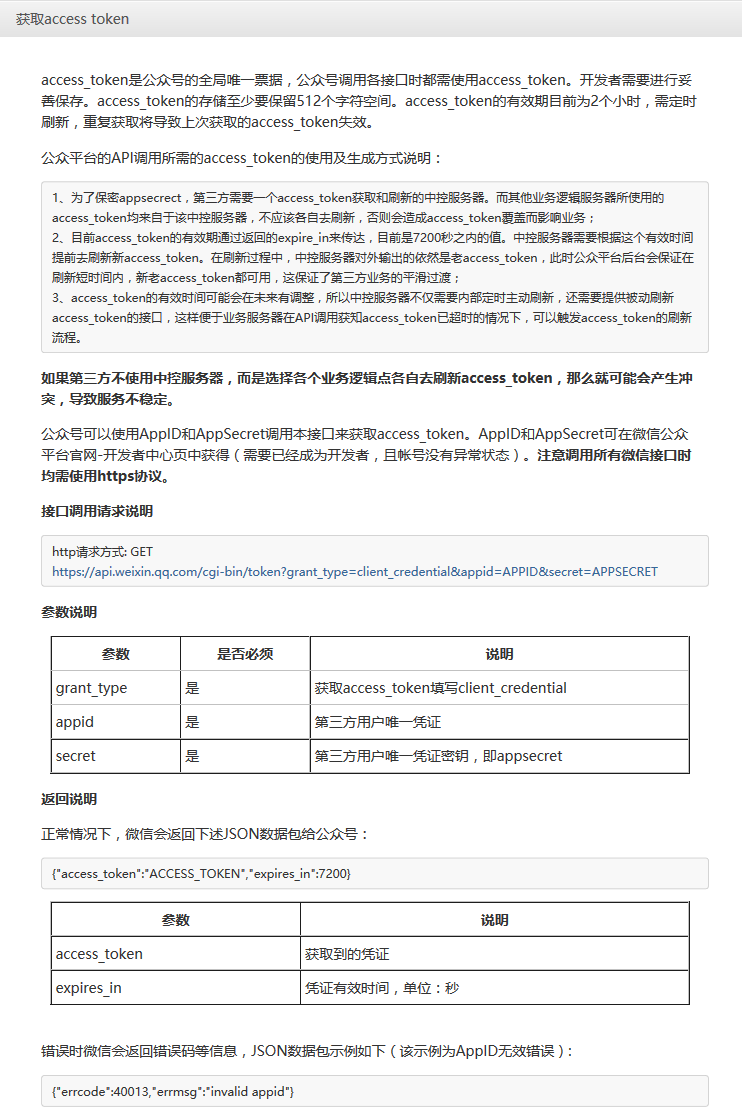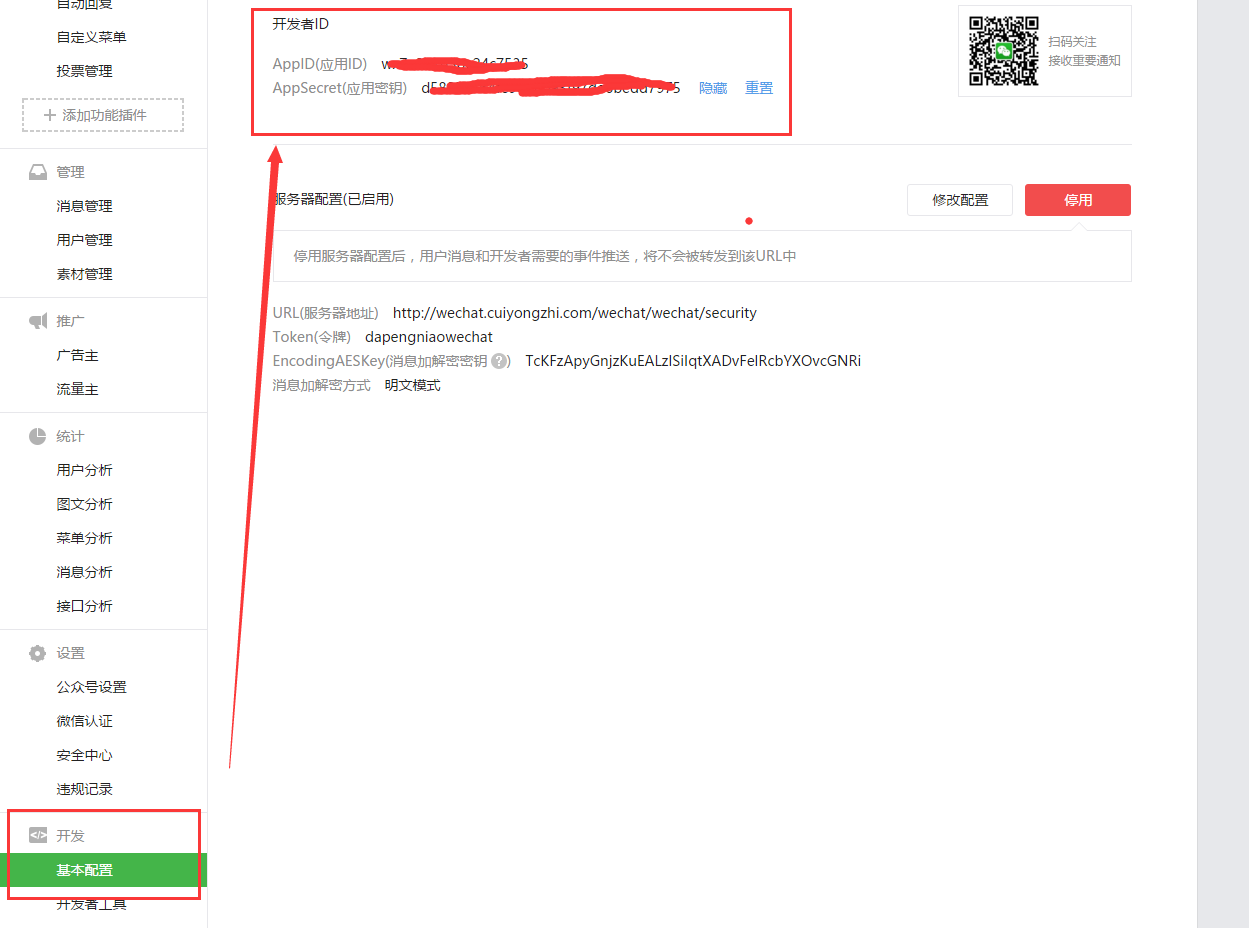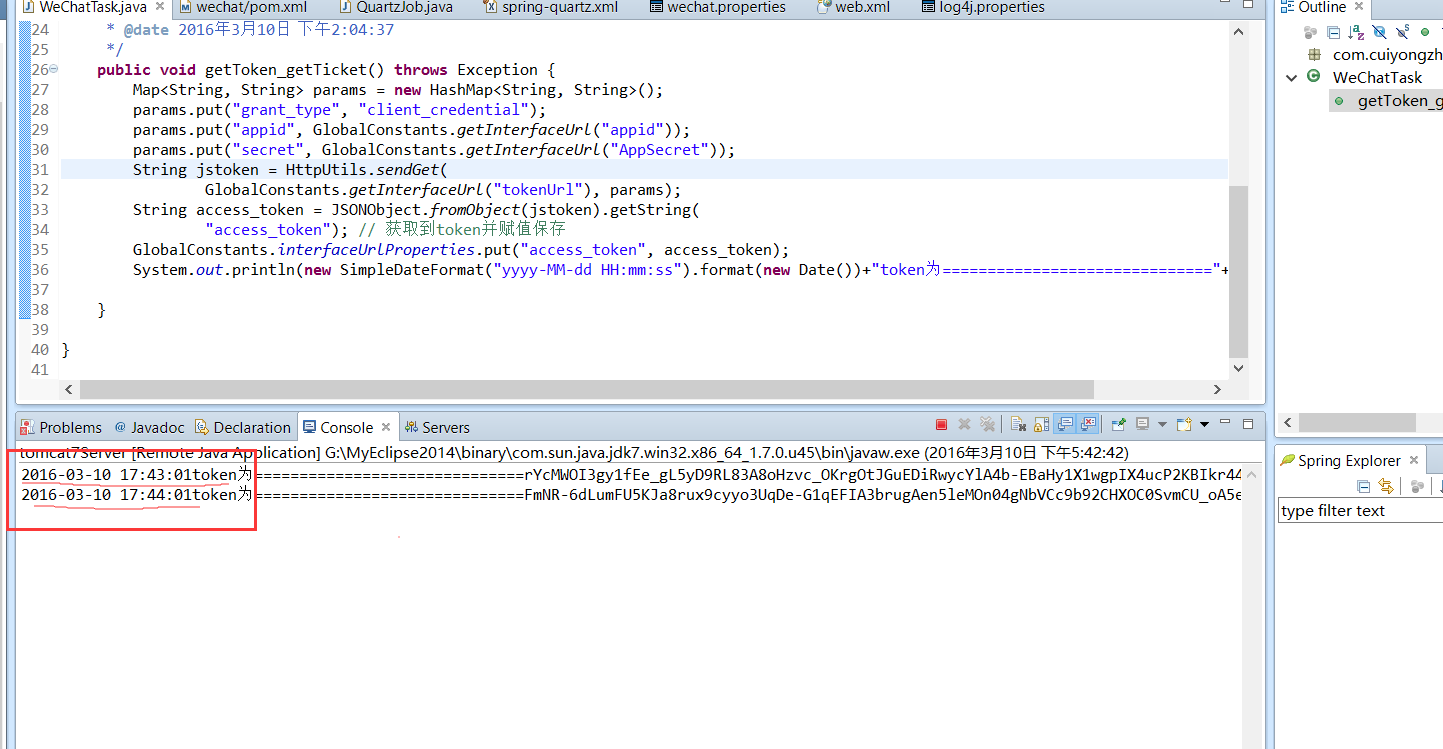您好,登錄后才能下訂單哦!
您好,登錄后才能下訂單哦!
微信公眾平臺開發使用Java如何實現獲取token?針對這個問題,這篇文章詳細介紹了相對應的分析和解答,希望可以幫助更多想解決這個問題的小伙伴找到更簡單易行的方法。
(一)token的介紹
引用:access_token是公眾號的全局唯一票據,公眾號調用各接口時都需使用access_token。開發者需要進行妥善保存。access_token的存儲至少要保留512個字符空間。access_token的有效期目前為2個小時,需定時刷新,重復獲取將導致上次獲取的access_token失效!
(二)token的獲取參考文檔
獲取的流程我們完全可以參考微信官方文檔:http://mp.weixin.qq.com/wiki/14/9f9c82c1af308e3b14ba9b973f99a8ba.html 如圖:

(三)token獲取流程分析
從公眾平臺獲取賬號的AppID和AppSecret;
token獲取并解析存儲執行體;
采用任務調度每隔兩小時執行一次token獲取執行體;
(四)token的獲取流程的具體實現
①獲取appid和appsecret
在微信公眾平臺【開發】——>【基本配置】中可以查看到我們需要的兩個參數:

這里我們將他們定義到我們的配置文件【wechat.properties】中,大致代碼為:
#獲取到的appid appid=wx7e32765bc24XXXX #獲取到的AppSecret AppSecret=d58051564fe9d86093f9XXXXX
②token獲取并解析存儲執行體的代碼編寫
由于在這里我們需要通過http的get請求向微信服務器獲取時效性為7200秒的token,所以我在這里寫了一個http請求的工具類,以方便我們的使用,如下:
package com.cuiyongzhi.wechat.util;
import java.io.BufferedInputStream;
import java.io.BufferedReader;
import java.io.IOException;
import java.io.InputStream;
import java.io.InputStreamReader;
import java.io.OutputStreamWriter;
import java.net.MalformedURLException;
import java.net.URI;
import java.net.URL;
import java.net.URLConnection;
import java.util.ArrayList;
import java.util.List;
import java.util.Map;
import java.util.Set;
import java.util.zip.GZIPInputStream;
import org.apache.http.HttpResponse;
import org.apache.http.NameValuePair;
import org.apache.http.client.ClientProtocolException;
import org.apache.http.client.HttpClient;
import org.apache.http.client.entity.UrlEncodedFormEntity;
import org.apache.http.client.methods.HttpGet;
import org.apache.http.client.methods.HttpPost;
import org.apache.http.entity.StringEntity;
import org.apache.http.impl.client.DefaultHttpClient;
import org.apache.http.message.BasicNameValuePair;
import org.apache.http.protocol.HTTP;
import org.apache.http.util.EntityUtils;
/**
* ClassName: HttpUtils
*
* @Description: http請求工具類
* @author dapengniao
* @date 2016年3月10日 下午3:57:14
*/
@SuppressWarnings("deprecation")
public class HttpUtils {
/**
* @Description: http get請求共用方法
* @param @param reqUrl
* @param @param params
* @param @return
* @param @throws Exception
* @author dapengniao
* @date 2016年3月10日 下午3:57:39
*/
@SuppressWarnings("resource")
public static String sendGet(String reqUrl, Map<String, String> params)
throws Exception {
InputStream inputStream = null;
HttpGet request = new HttpGet();
try {
String url = buildUrl(reqUrl, params);
HttpClient client = new DefaultHttpClient();
request.setHeader("Accept-Encoding", "gzip");
request.setURI(new URI(url));
HttpResponse response = client.execute(request);
inputStream = response.getEntity().getContent();
String result = getJsonStringFromGZIP(inputStream);
return result;
} finally {
if (inputStream != null) {
inputStream.close();
}
request.releaseConnection();
}
}
/**
* @Description: http post請求共用方法
* @param @param reqUrl
* @param @param params
* @param @return
* @param @throws Exception
* @author dapengniao
* @date 2016年3月10日 下午3:57:53
*/
@SuppressWarnings("resource")
public static String sendPost(String reqUrl, Map<String, String> params)
throws Exception {
try {
Set<String> set = params.keySet();
List<NameValuePair> list = new ArrayList<NameValuePair>();
for (String key : set) {
list.add(new BasicNameValuePair(key, params.get(key)));
}
if (list.size() > 0) {
try {
HttpClient client = new DefaultHttpClient();
HttpPost request = new HttpPost(reqUrl);
request.setHeader("Accept-Encoding", "gzip");
request.setEntity(new UrlEncodedFormEntity(list, HTTP.UTF_8));
HttpResponse response = client.execute(request);
InputStream inputStream = response.getEntity().getContent();
try {
String result = getJsonStringFromGZIP(inputStream);
return result;
} finally {
inputStream.close();
}
} catch (Exception ex) {
ex.printStackTrace();
throw new Exception("網絡連接失敗,請連接網絡后再試");
}
} else {
throw new Exception("參數不全,請稍后重試");
}
} catch (Exception ex) {
ex.printStackTrace();
throw new Exception("發送未知異常");
}
}
/**
* @Description: http post請求json數據
* @param @param urls
* @param @param params
* @param @return
* @param @throws ClientProtocolException
* @param @throws IOException
* @author dapengniao
* @date 2016年3月10日 下午3:58:15
*/
public static String sendPostBuffer(String urls, String params)
throws ClientProtocolException, IOException {
HttpPost request = new HttpPost(urls);
StringEntity se = new StringEntity(params, HTTP.UTF_8);
request.setEntity(se);
// 發送請求
@SuppressWarnings("resource")
HttpResponse httpResponse = new DefaultHttpClient().execute(request);
// 得到應答的字符串,這也是一個 JSON 格式保存的數據
String retSrc = EntityUtils.toString(httpResponse.getEntity());
request.releaseConnection();
return retSrc;
}
/**
* @Description: http請求發送xml內容
* @param @param urlStr
* @param @param xmlInfo
* @param @return
* @author dapengniao
* @date 2016年3月10日 下午3:58:32
*/
public static String sendXmlPost(String urlStr, String xmlInfo) {
// xmlInfo xml具體字符串
try {
URL url = new URL(urlStr);
URLConnection con = url.openConnection();
con.setDoOutput(true);
con.setRequestProperty("Pragma:", "no-cache");
con.setRequestProperty("Cache-Control", "no-cache");
con.setRequestProperty("Content-Type", "text/xml");
OutputStreamWriter out = new OutputStreamWriter(
con.getOutputStream());
out.write(new String(xmlInfo.getBytes("utf-8")));
out.flush();
out.close();
BufferedReader br = new BufferedReader(new InputStreamReader(
con.getInputStream()));
String lines = "";
for (String line = br.readLine(); line != null; line = br
.readLine()) {
lines = lines + line;
}
return lines; // 返回請求結果
} catch (MalformedURLException e) {
e.printStackTrace();
} catch (IOException e) {
e.printStackTrace();
}
return "fail";
}
private static String getJsonStringFromGZIP(InputStream is) {
String jsonString = null;
try {
BufferedInputStream bis = new BufferedInputStream(is);
bis.mark(2);
// 取前兩個字節
byte[] header = new byte[2];
int result = bis.read(header);
// reset輸入流到開始位置
bis.reset();
// 判斷是否是GZIP格式
int headerData = getShort(header);
// Gzip 流 的前兩個字節是 0x1f8b
if (result != -1 && headerData == 0x1f8b) {
// LogUtil.i("HttpTask", " use GZIPInputStream ");
is = new GZIPInputStream(bis);
} else {
// LogUtil.d("HttpTask", " not use GZIPInputStream");
is = bis;
}
InputStreamReader reader = new InputStreamReader(is, "utf-8");
char[] data = new char[100];
int readSize;
StringBuffer sb = new StringBuffer();
while ((readSize = reader.read(data)) > 0) {
sb.append(data, 0, readSize);
}
jsonString = sb.toString();
bis.close();
reader.close();
} catch (Exception e) {
e.printStackTrace();
}
return jsonString;
}
private static int getShort(byte[] data) {
return (data[0] << 8) | data[1] & 0xFF;
}
/**
* 構建get方式的url
*
* @param reqUrl
* 基礎的url地址
* @param params
* 查詢參數
* @return 構建好的url
*/
public static String buildUrl(String reqUrl, Map<String, String> params) {
StringBuilder query = new StringBuilder();
Set<String> set = params.keySet();
for (String key : set) {
query.append(String.format("%s=%s&", key, params.get(key)));
}
return reqUrl + "?" + query.toString();
}
}我們在做http請求的時候需要目標服務器的url,這里在項目中為了方便對url的管理我們在資源目錄下建立了interface_url.properties用于存放目標url,這里我們將請求token的url存入:
#獲取token的url tokenUrl=https://api.weixin.qq.com/cgi-bin/token
我們需要將我們配置的配置文件在項目初始化后能得到啟動,所以我在這里加入一個項目初始化的代碼實現,用于項目啟動初始化interface_url.properties和wechat.properties中的配置:
package com.cuiyongzhi.web.start;
import javax.servlet.ServletConfig;
import javax.servlet.ServletException;
import javax.servlet.http.HttpServlet;
/**
* ClassName: InterfaceUrlIntiServlet
* @Description: 項目啟動初始化servlet
* @author dapengniao
* @date 2016年3月10日 下午4:08:43
*/
public class InterfaceUrlIntiServlet extends HttpServlet {
private static final long serialVersionUID = 1L;
@Override
public void init(ServletConfig config) throws ServletException {
InterfaceUrlInti.init();
}
}初始化的具體實現,將初始化過后的方法都存入到GlobalConstants中方便項目中隨意調用,如下:
package com.cuiyongzhi.web.start;
import java.io.IOException;
import java.io.InputStream;
import java.util.Properties;
import com.cuiyongzhi.web.util.GlobalConstants;
/**
* ClassName: InterfaceUrlInti
* @Description: 項目啟動初始化方法
* @author dapengniao
* @date 2016年3月10日 下午4:08:21
*/
public class InterfaceUrlInti {
public synchronized static void init(){
ClassLoader cl = Thread.currentThread().getContextClassLoader();
Properties props = new Properties();
if(GlobalConstants.interfaceUrlProperties==null){
GlobalConstants.interfaceUrlProperties = new Properties();
}
InputStream in = null;
try {
in = cl.getResourceAsStream("interface_url.properties");
props.load(in);
for(Object key : props.keySet()){
GlobalConstants.interfaceUrlProperties.put(key, props.get(key));
}
props = new Properties();
in = cl.getResourceAsStream("wechat.properties");
props.load(in);
for(Object key : props.keySet()){
GlobalConstants.interfaceUrlProperties.put(key, props.get(key));
}
} catch (IOException e) {
e.printStackTrace();
}finally{
if(in!=null){
try {
in.close();
} catch (IOException e) {
e.printStackTrace();
}
}
}
return;
}
}當我們把所有的準備工作都做好了之后我們可以開始真正的去獲取token了,這里我們將獲取到的token解析之后依然存儲到GlobalConstants中方便使用,簡單代碼如下:
package com.cuiyongzhi.wechat.common;
import java.util.HashMap;
import java.util.Map;
import net.sf.json.JSONObject;
import com.cuiyongzhi.web.util.GlobalConstants;
import com.cuiyongzhi.wechat.util.HttpUtils;
/**
* ClassName: WeChatTask
* @Description: 微信兩小時定時任務體
* @author dapengniao
* @date 2016年3月10日 下午1:42:29
*/
public class WeChatTask {
/**
* @Description: 任務執行體
* @param @throws Exception
* @author dapengniao
* @date 2016年3月10日 下午2:04:37
*/
public void getToken_getTicket() throws Exception {
Map<String, String> params = new HashMap<String, String>();
params.put("grant_type", "client_credential");
params.put("appid", GlobalConstants.getInterfaceUrl("appid"));
params.put("secret", GlobalConstants.getInterfaceUrl("AppSecret"));
String jstoken = HttpUtils.sendGet(
GlobalConstants.getInterfaceUrl("tokenUrl"), params);
String access_token = JSONObject.fromObject(jstoken).getString(
"access_token"); // 獲取到token并賦值保存
GlobalConstants.interfaceUrlProperties.put("access_token", access_token);
System.out.println(new SimpleDateFormat("yyyy-MM-dd HH:mm:ss").format(new Date())+"token為=============================="+access_token);
}
}(三)采用任務調度每隔兩小時執行一次token獲取執行體
我們閱讀過微信的文檔會發現我們的token獲取的接口每天是有調用次數限制的,為了防止我們業務量比較大的情況下token的直接調用的接口次數不夠用,所以我們需要根據token的時效性(7200s)在自己的業務服務器上做到token的緩存并定時獲取,我這里用到的任務調度的方式是采用quartz,有關quartz的使用可以參考文章 http://cuiyongzhi.com/?tags=%E5%AE%9A%E6%97%B6%E4%BB%BB%E5%8A%A1 ,下面具體代碼的實現:
package com.cuiyongzhi.wechat.quartz;
import org.apache.log4j.Logger;
import com.cuiyongzhi.wechat.common.WeChatTask;
public class QuartzJob{
private static Logger logger = Logger.getLogger(QuartzJob.class);
/**
* @Description: 任務執行獲取token
* @param
* @author dapengniao
* @date 2016年3月10日 下午4:34:26
*/
public void workForToken() {
try {
WeChatTask timer = new WeChatTask();
timer.getToken_getTicket();
} catch (Exception e) {
logger.error(e, e);
}
}
}這里新建配置文件spring-quartz.xml以方便quartz任務的管理和啟用,這里將我們需要用到的workForToken()加入到執行任務中:
<?xml version="1.0" encoding="UTF-8"?>
<!DOCTYPE beans PUBLIC "-//SPRING//DTD BEAN//EN" "http://www.springframework.org/dtd/spring-beans.dtd">
<beans>
<!-- 要調用的工作類 -->
<bean id="quartzJob" class="com.cuiyongzhi.wechat.quartz.QuartzJob"></bean>
<!-- 定義調用對象和調用對象的方法 -->
<bean id="jobtaskForToken"
class="org.springframework.scheduling.quartz.MethodInvokingJobDetailFactoryBean">
<!-- 調用的類 -->
<property name="targetObject">
<ref bean="quartzJob" />
</property>
<!-- 調用類中的方法 -->
<property name="targetMethod">
<value>workForToken</value>
</property>
</bean>
<!-- 定義觸發時間 -->
<bean id="doTimeForToken" class="org.springframework.scheduling.quartz.CronTriggerBean">
<property name="jobDetail">
<ref bean="jobtaskForToken" />
</property>
<!-- cron表達式 -->
<property name="cronExpression">
<value>0 0/1 * * * ?</value>
</property>
</bean>
<!-- 總管理類 如果將lazy-init='false'那么容器啟動就會執行調度程序 -->
<bean id="startQuertz" lazy-init="false" autowire="no"
class="org.springframework.scheduling.quartz.SchedulerFactoryBean">
<property name="triggers">
<list>
<ref bean="doTimeForToken" />
</list>
</property>
</bean>
</beans>這里我為了測試將執行間隔時間設置成了1分鐘一次,根據需要可以自行修改執行時間;最后我們需要在我們的web.xml啟動項中開啟quartz的使用:
<context-param> <param-name>contextConfigLocation</param-name> <param-value>classpath:spring.xml,classpath:spring-mybatis.xml,classpath:spring-quartz.xml</param-value> <!-- ,classpath:spring-quartz.xml 用于做任務調度 任務定時都可以 --> </context-param>
當這一切都準備完畢之后我們啟動項目,會發現每間隔一分鐘就會有token獲取到,這里我是將其存儲在項目變量中,但是如果需要考慮到項目橫向擴展這里建議將token存儲到緩存中;運行結果如下:

關于微信公眾平臺開發使用Java如何實現獲取token問題的解答就分享到這里了,希望以上內容可以對大家有一定的幫助,如果你還有很多疑惑沒有解開,可以關注億速云行業資訊頻道了解更多相關知識。
免責聲明:本站發布的內容(圖片、視頻和文字)以原創、轉載和分享為主,文章觀點不代表本網站立場,如果涉及侵權請聯系站長郵箱:is@yisu.com進行舉報,并提供相關證據,一經查實,將立刻刪除涉嫌侵權內容。